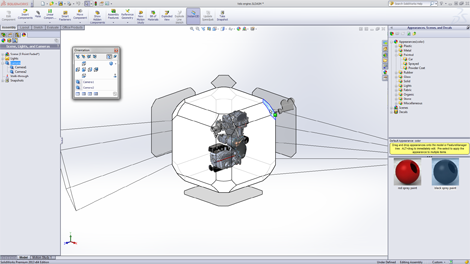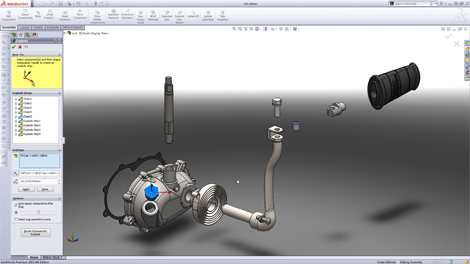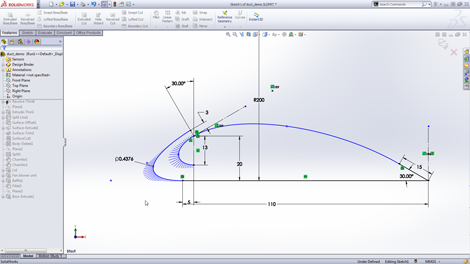
I spent a day last week in the company of the SolidWorks folks at their rather spiffy new campus just outside of Waltham, Massachusetts. Why? To take a whizz through what’s new in SolidWorks 2013 and to catch up with what the company is up to in general.
While I’m currently working on an in-depth review with my ol’ buddy Jeff Mirisola for the next issue, the day’s activities and subsequent chatter on the internet (read: yacking when I should be working, on twitter) raised an interesting question.
What constitutes a “good release”?
It’s a deceptively simple question. What should a software developer provide to you, the customer, to have it considered as a good thing? Each year, each 18 months, whatever the actual revision cycle, software companies bring on stream more tools to their user community. Each is a fixed point in time, a frozen deliverable, that’s shipped, downloaded and used. The answer is a complex one that’s worth exploring further and with SolidWorks’ next move ready to go shortly, now is a good time.
General vs Specialised
When software is released, I tend to split the updates and changes made in two different categories. There are those updates made that are applicable to almost every user. Things that are made to the core of the system that influence how a user interacts with it.
With 2013, a good example of generally applicable update is the new view manipulation widget. Hitting the space bar brings up a familiar dialog for selecting set views (Front, back, iso, trimetric etc etc) as well as any custom views you define. This type of functionality has been in SolidWorks since I can remember.

What’s changed for this release is a new graphic interface for looking at a 3D model, selecting faces on a bounding cube, corners (for a isometric view etc) as well as interacting with cameras if you have them defined. As you can see it’s pretty slick.

Another good example are the new exploded view tools. Rather than just having a single exploded view, multiples can now be added, saved and reused. Whether for animations, for presentation renderings, for technical illustrations or of course, for drawings. There are many occasions when different exploded views are required – general assembly drawings or to show specific functionality or aspect of a product.
There’s also the new intersect tool. This combines things like cut and extrude to surface, boolean editing and other separate tasks into a single operation. It’ll adjust, cut, hack and splice your geometry according to a reference face or surface set. While I’m sure those working with complex shapes will use this the most, it’s applicable to the majority rather than the minority of users.

While we’re on the subject of drawings, the simple fact that drawing view creation is now a multi-threaded calculation means that when you’re laying out or indeed, updating large drawing sheets of complex components, the process should be much much speedier.
But what of the more specialised updates? There’s a good few of these. A perfect example is the ability to create conics. Whether you’re working in industrial design, turbo machinery design or just have the requirement to create very specific geometry forms, then the ability to create them solves an issue. Instantly. All the tangency controls are there and they work.

Moving on to other specialised updates, there a whole truck load coming. Tools to assist CAD administrators that let’s you not only see how each seat in your site is performing, but also spot hardware issues, where resources are over or under used. Why specialised? Because most users won’t care. But their admin person will and they’ll make great use of it assuming IT will allow the information to be communicated back to SolidWorks support servers. There’s a whole bunch of updates to the simulation tools as well that are worth exploring further.
The weight of history
SolidWorks, like most of its competition, has been on the market for over a decade. Once software gets to that ripe old age, you always see the same thing happen. Development transitions from breaking new ground with each release, whole swathes of new functionality added, to more subtle refinements. Why is that?
It’s down to two factors. Firstly, as each system matures, it has a previous history of stuff that it can already do. If it already does more things, it’s hard for the developers to add new, big bang feature sets. Secondly, as a community of users builds, the investment of their learning and the effect of dramatic changes, hangs over the system like Damocles’ Sword. In other words, as you have more people using the system, greater the numbers of people you potential risk pissing off by making dramatic changes to the application.
There are now half a million commercial seats of SolidWorks out there. You can probably reduce that number when you consider staffing changes, close downs of companies, departments. Laws of atrophy apply to software as they do in everything else. But still, that’s one hell of a lot of people.
Are all of them going to consider this a good release? And it’s dependent on many things. Some of the most advanced users, pushing the boundaries of what the system can do, particularly in the field of highly complex shape design, might feel that there’s nothing in this release for them. Conversely, they might find the addition of conics solves a huge problem. They might not.
A market changed…
SolidWorks grew up in a very different world to the one in which we now operate. Consider when the system started – 1995. The internet was nascent. Much of what we learned about design software was done through trade magazines, through word of mouth, through trade shows, through filling out pieces of cardboard and getting a paper brochure through the post. It also grew through hiring resellers that came from other software vendors, had potential customers in hand to sell something new to.
But the company grew into the internet age. Users were more connected than ever before and SolidWorks took advantage of it. Those that remember comp.cad.solidworks usenet group will remember a heady time when users took this new connectivity and made it their own. SolidWorks worked smart and engaged with the customers – more than any other vendor had done before. Why? Because it could and did it intelligently.
The V6 question
That same environment that did the company so much good has also caused it a few problems of late and that of course, brings me onto the subject of the “next generation”, SolidWorks V6 or whatever it’s going to be called. A simple presentation was made to show users what was coming, what the company might have been working on (I have an illicit video of it still). Based on the power of Catia, it looked good. But the company made much of the benefits of the cloud. Right at a point where the Cloud was a misunderstood term (and arguably is). And that was the fundamental mistake.
Speculation amongst those same highly connected users that built the company took this relatively simple message, span it, misconstrued and built up a resistance to a future product that hasn’t even been seen since – and has since been rethought greatly from that original form. The SolidWorks community, wherever it lives (blogs, forums etc) now has a swath of criticism, posturing, denigration and frankly often disturbing commentary on something that simple didn’t exist outside of a development lab. Basically, it went nuts.
And the fact that SolidWorks hasn’t communicated its strategy clearly since, hasn’t helped.
One phrase that comes up is “Kernel Change.” This is a huge issue. There’s a common misconception out there that SolidWorks is stripping out Parasolid and shoehorning in the geometry engine from Catia. No. It’s not. What it’s doing is build a new product, based on powerful, in house technology. SolidWorks as we know it going to continue for a good long while yet.
Even at a gathering of the press, only a few months before this new system comes out of the labs and into a very tightly controlled alpha test stage, the company is very tight lipped. The New Thing is now being referred to as a “Conceptual Mechanical Design” system. That’s all we know for now. But it’s coming and soon.
So is it a good release?
This is entirely dependent on where your daily work lies and is the crux of my thoughts. Are you using the system for prismatic modelling? Then things like the new variable patterns will be a boon, allowing you to create a single feature, with multiple parametric changes made to each instance where need – rather than knife and forking each feature.
If you’ve struggled with complex shape design, then the intersect tool with make life more efficient. Are you creating as many, if not more, drawings than models? Then the simple hardware acceleration is going mean less coffee breaks and yacking in the office. Which isn’t necessarily a bad thing in these time pressured days.
But what if, like many users, you use the same tools you’ve always used. Then the chances are it’s possible to look at all the updates in this release and just think “Whatever”. And each year’s subscription cash in these harsh economic times, is increasingly more difficult to justify when you already have a powerful toolset at hand and working.
There’s also the simple fact that today, unlike when SolidWorks launched, users know what else is out there. Look at what’s gaining attention now. Sub-Divisional modelling from the likes of t-Splines, Modo and even in Creo, is looking like a hot topic amongst the technology savvy users. Direct modelling is also out there and more widely understood than ever before. Users can try these things out, see how they work, from their desk. Instantly.
That means that users are no longer stuck within their own localised community of users. They know what’s out there. They can see what other users are talking about, whether they share the same technological tribal loyalties or not. Today, designers and engineers know what they want and if they don’t get it in their own system, they start to get antsy, looking around for other solutions or workflows. And once the idea sticks that those tools aren’t coming soon, this accelerates.
SolidWorks 2013, when taken as a whole, is an impressive release. It brings combinations of rationalisation of existing multiple feature workflows into a single feature, enhancements to existing tools and a decent smattering of brand new things.
But will you, as a user, find it the same? As ever, it depends on what you do, how you do it and what your boss wants (the vast majority of users are within a team environment, not a sole entity). A couple of features here and there that make a difference to how you work, make you more efficient, mean a good release. There are very few users that will run the gamut of the system, use everything and anything in there. But it’s evolution of an existing system, of existing tools – albeit an impressive one.
And here’s the point.
In today’s market, users don’t just want evolution of their existing tools. They’re aware of what’s out there, what technology is available and they want it. What I just hope is that Dassault/SolidWorks realise this and take it on board as they’re finalising their new product introduction. It’s been too long coming since it was discussed first. The user community wants to know, so they can factor it in, can plan ahead, see where it fits into their specialise workflows. SolidWorks still has an incredible passionate and loyal user community that will, I’m convinced, eagerly adopt whatever is coming.
But if it doesn’t get something truly spectacular, then an opportunity will be lost and the damage done. But as I said earlier, SolidWorks as we know it will continue for many years. About the same number of users as Luxembourg has as residents, it has to. There’s too much at stake.
The team has a whole bunch of resources at the launch site (www.solidworks.com/launch) to help find out what’s new and its worth exploring to see what effects your workflow and can make life easier. There’s also a huge bunch of bloggers out there champing at the bit to show you what they’re learning. Some of the most notable are:
Dan Hertzbergererer has his thing over at danherzberg.posterous.com
Ricky Jordan, as ever, breaks things down rather nicely at www.rickyjordan.com
I’m sure Lou Gallo will be covering things in his excellent Podcasts – www.solidworksheard.com






